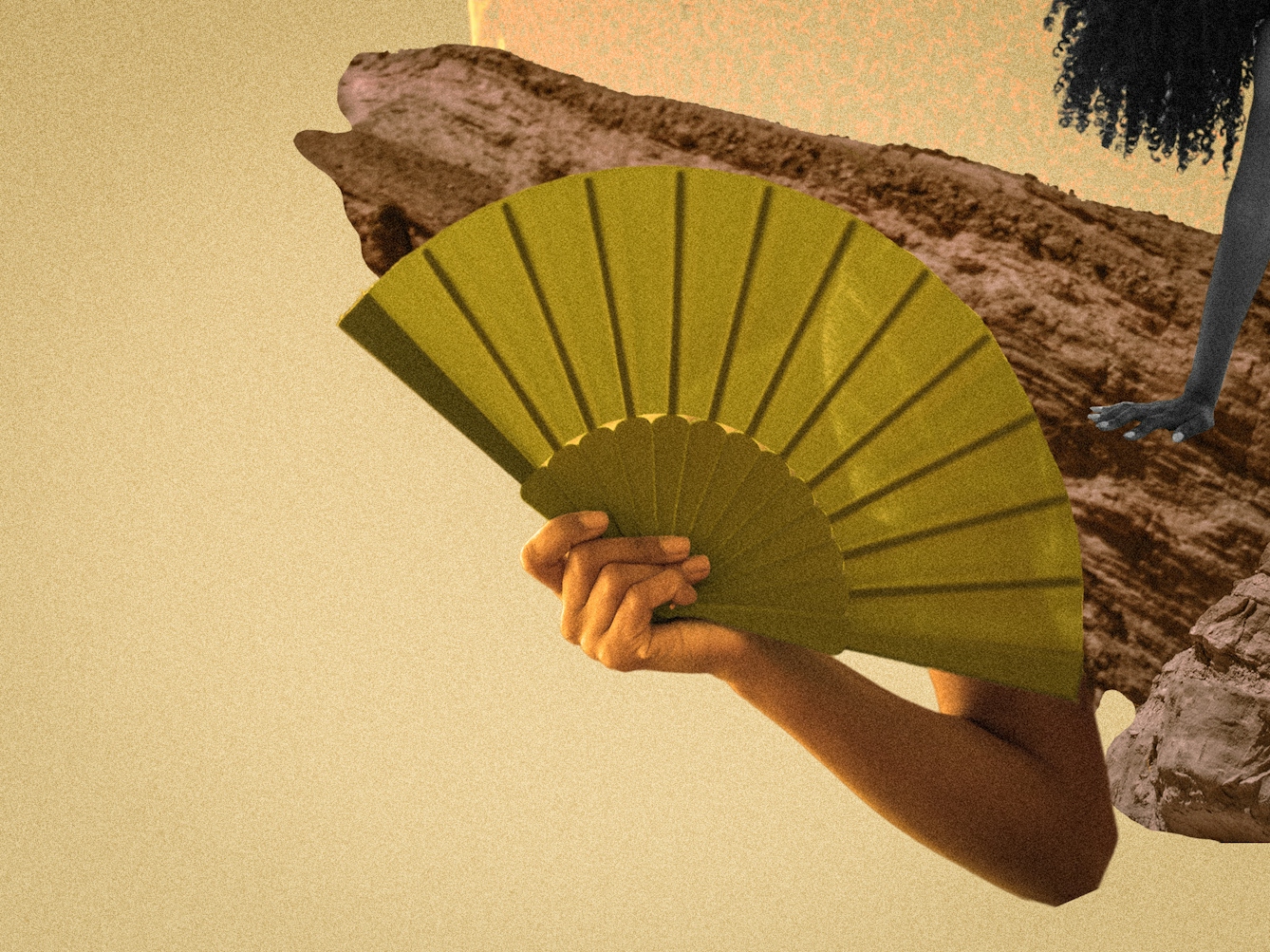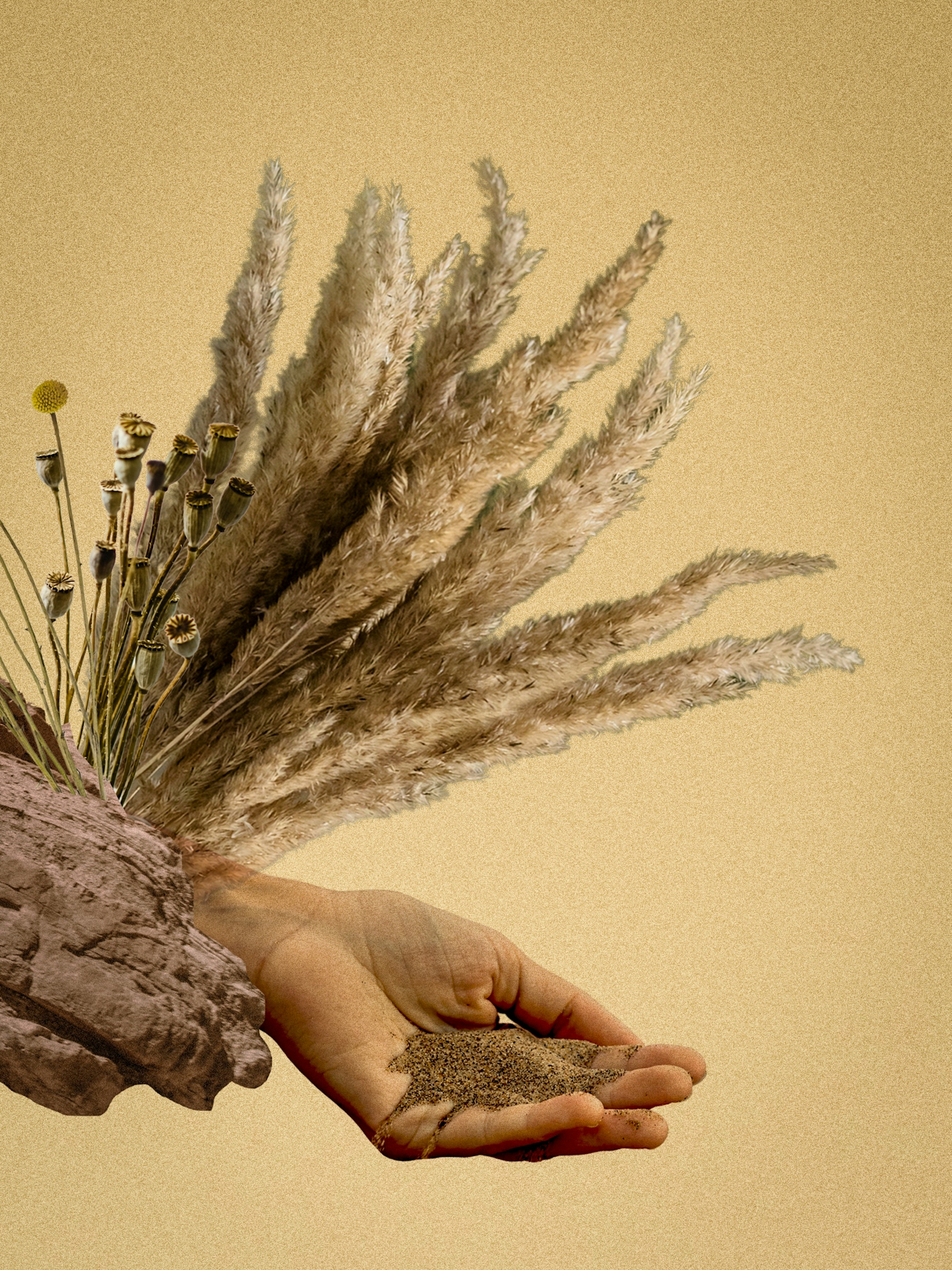Menopause doesn’t have to signify old age, but when history tells women that the end of fertility and other symptoms mean the end of their useful lives, it’s hard to resist the idea. Especially when your body feels like it’s letting you down.
Heating up and drying out
Words by Helen FosterEast Midlands Oral History Archiveartwork by Asma Istwaniaverage reading time 7 minutes
- Article
- Serial

Having a hot flush (also known as a hot flash) is one of the most common clichés of a menopausal woman. A hot flush is a sudden and intense sensation of heat around the upper body, sometimes accompanied by profuse sweating and flushed skin. A hot flush that happens at night is called a night sweat.
Perhaps it is because they are such a visible sign of menopause, hot flushes can cause embarrassment and shame for some. Clare felt like she was letting herself down, “like somehow I was failing my own human biology”.
The medical term for hot flushes is “vasomotor symptoms” and they are the most common menopausal symptom, experienced by four out of five people who go through menopause. The cause is believed to be associated with fluctuating levels of the hormone oestrogen, which affects the hypothalamus, the part of the brain that controls temperature in the body.
Heat was an important feature of the humoral system, which dominated much of Western medicine for well over a thousand years. The body was believed to be comprised of four humours: blood, yellow bile, black bile and phlegm; when these were in balance and well mixed, the body was in good health.
However, a deficiency or excess in one or more of the humours or a separation of one part from the others was believed to be the cause of pain and ill health. One of the signs that the humours were out of balance was overheating and fevers.

“A hot flush is a sudden and intense sensation of heat around the upper body, sometimes accompanied by profuse sweating and flushed skin.”
Treating hot flushes
The most common treatments for restoring the balance of the humours were bloodletting and purging. While there was lots of advice on how to prevent a dangerous build-up of humours by inducing menstruation in 17th-century medical texts, there’s little mention of treating menopausal symptoms.
Hot flushes and other menopausal symptoms are mentioned in the anonymous 1670 publication ‘An account of the causes of some particular rebellious distempers’, which recommends ‘True Balsamic Electuary’ as a treatment, as “It wonderfully corrects and alters the heat, thinness and sharpness of the Blood, which occasions immoderate or over-flowing of the Courses of Nature, by which many are reduc’d to a very low and dangerous condition, and that more especially in Elderly Women.” The author advises that the balsamic electuary should be accompanied by purging.
The 19th-century physician Edward Tilt recognised hot flushes and sweating as symptoms of menopause, observing that “at the change of life most women have the power of generating a more than usual amount of heat; they often want less clothing, and even in winter leave their doors and windows wide open”. He described how sometimes “this caloric bursts forth as flushes… spreading over the chest and then over the face, which becomes suffused and hot”. Tilt prescribed bloodletting and purges as primary treatments for menopausal symptoms in order to restore balance and “strengthen the patient’s constitution”.
Many in the medical establishment – with no real medical basis – continued to believe that hot flushes were a result of a woman’s emotional state. In 1903, American health lecturer Mary Ries Melendy (1841–1927), writing in ‘Perfect Womanhood for Maidens – Wives – Mothers’, recommended fasting as a relief for flushes and sweats. She cautioned that “the mind should not continually dwell upon itself”, advocating that menopausal women should “elevate the spirit and the body will grow strong”.
As the causes of menopause shifted to hormone deficiency, treatment focused on hormone replacement therapy (HRT). An early example was gynaecologist Emil Novak, who suggested the use of “glandular ovarian substances”, an early form of HRT.

“Dropping oestrogen levels can cause thinning, drying and inflammation of the vaginal walls.”
Vaginal dryness
Another common symptom of menopause is vaginal dryness or vaginal atrophy. Dropping oestrogen levels can cause thinning, drying and inflammation of the vaginal walls. This can result in discomfort and pain, painful or uncomfortable sexual intercourse, and can also cause related issues, such as urinary tract infections.
Because of its intimate nature, many women, like Paula, are reluctant to talk to their doctor about vaginal dryness, despite the painful tearing of the skin and risk of infection.
In the 12th century, a rare female voice, the physician and medical writer, Trota of Salerno, suggested that a woman may continue to have periods beyond the age of 50, but only “if she is moist”. In the medieval context this would have been a reference to the balance of humours. The humoral system focused on peoples’ ‘natures’: their constitutions and emotions, as well as their physiological condition in terms of balance of the four humours.
At birth the natural condition of the body was characterised as warm and wet. Over a lifetime there would have been a loss of heat and moisture, and in old age a person would become cold and dry. Taken in tandem with the notion that menstruation was a way of expelling poisonous blood from the body, the ending of periods in middle age would cast menopausal women as becoming tainted and out of balance.
Today the medical treatment for vaginal dryness is often a topical hormone cream or regular HRT, but many people will also seek their own solutions before they see a doctor. As a regular cyclist, Fiona tried several methods of alleviating vaginal dryness and sensitivity.

Older women have played an essential role and their communities would struggle to survive without them.
Dried-up old women
The image of women drying up in old age persists and continues to influence the way contemporary women talk about vaginal dryness. For Helen, the effects of declining oestrogen levels represent “ageing staring you in the face”.
Throughout history the ageing female body has been framed as defective and redundant, and the language and imagery that is used to talk about menopausal symptoms continues to reinforce this thinking. In the early 20th century, Mary Ries Melendy believed that even if a woman is in good health at menopause, “the reproductive organs have finished their work” and therefore most menopausal women lose interest in sex.
Menopause in the 20th century was framed as a medical condition that robbed women of their youth and femininity. With the development of HRT, pharmaceutical companies, perpetuated the idea that hormone-based products could halt this ‘decline’. American gynaecologist Robert Wilson advised women to take HRT for the rest of their lives in order to stay “feminine forever”.
The evolution of older women
In evolutionary terms, many women live well beyond menopause and fertility. Why would this be if they serve no useful function? Anthropologist Kristen Hawkes points to the Hadza, a Tanzanian community, as an example of the traditional role of older women in society. She observed that women past child-bearing age were often the most prolific foragers for food and played an essential role in communal childcare and supporting nursing mothers. Without them, communities might struggle to survive.
The hot flush and vaginal dryness remain two of the most common and, for many, the most awkward symptoms of menopause. Managing them can be doubly difficult if they are also seen as signs of failure and decline. Perhaps it’s time to change how we think about menopause and its symptoms, not as signs of drying up, ageing and becoming irrelevant, but more like that other period of hormonal change, adolescence, a rite of passage. As Claire says, why not “kind of embrace it and try to be curious about it and marvel at it”.
About the contributors
Helen Foster
Dr Helen Foster is a writer and oral historian currently based at the East Midlands Oral History Archive at the University of Leicester. She has a particular interest in narratives around life stages and, as well as menopause, her work has explored childlessness and bereavement. As a poetry-therapy practitioner she facilitates workshops for people living with mental health challenges, using writing as a therapeutic tool. She is currently co-authoring a book on creative writing and health for Emerald Press.

East Midlands Oral History Archive
The audio extracts used in the series ‘A Bloody History of Menopause’ come from interviews, conversations and audio diaries about lived experiences of menopause recorded for the Silent Archive project. The project was led by the East Midlands Oral History Archive at the University of Leicester (from 2020–22) and funded by the National Lottery Heritage Fund.
Asma Istwani
Asma is an artist and arts producer from London. She has worked with several organisations and brands, including Tate, Somerset House and Jo Malone London on a variety of creative projects. Through her collages she aims to make relatable statements about the experience and racial and sexual depiction of ‘othered’ women, with special interest in those who, like herself, make up the SWANA (South West Asian/ North African) diaspora. Asma is also the founder of RIOT SOUP, an art collective and community for Black and Brown women artists in London.

